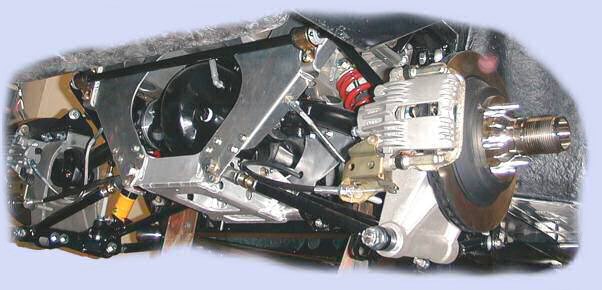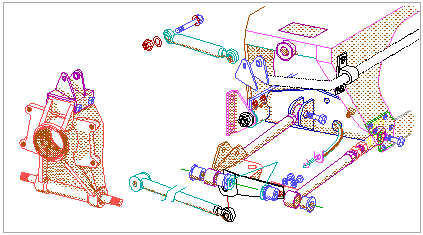Our Optional Rear
Suspension

Like our standard setup, the rear suspension is mounted in a subframe, but
in aluminum rather than steel. The subframe is mounted to the chassis
through urethane bushings, reducing noise and vibration while maintaining
precise suspension geometry.
The unit is designed to be fully
adjustable - very tunable for the track, although it isn't of
much advantage on a street car. In our standard Jaguar based suspension,
there was one problem: the Jaguar inboard brakes were cooled poorly
under track conditions. (We do offer some optional brakes to cure the problem,
but they're pretty pricy.) These outboard brakes will cure that problem -
standard. Calipers are from the late model Corvette/Camaro, and have
an integral emergency brake if desired. Light, efficient, reasonably
cheap - and built for a car that weighs 30% more than our 289. The
vented rotors are 11.75" Wilwood units,
.810" thick.
| We cast our own aluminum hub carriers for this rear suspension, but it
still uses the same Jaguar stub axles, bearings and seals. All of the
pieces are reasonably priced and well proven in our 427.
We were able to get exactly the geometry we wanted,
using the axle as the upper link, so
why have the added complication, weight and expense of a variable-length
axle? The axial stress in the shaft is small compared to the torsional
stress, and the axle shafts have proven extremely reliable under all conditions
because of our special manufacturing
technique and fail-safe design. We've lowered the roll
center and decreased the camber change a bit from the Jag for more predictable
handling under track conditions. There is also more anti-squat built
into the geometry.
Every unit has an adjustable link for the anti-sway bar so that you can do
some micro-tweeking of the front and rear balance at the track. |
Every rear suspension that we build (unless you don't want it) comes standard with a rebuilt Powerlok© limited-slip differential. |
 |
The hub carrier is located firmly in every direction,. At the bottom
toe and camber is controlled by two radius arms with adjustable nylon-lined
rod ends at the inside and urethane bushings at the hub carrier, plus a trailing
arm with the same combination of rod end and urethane bushing. At the
top, there's a trailing arm with rod ends at both ends, plus the drive axle
acting as a radius rod.
The subframe is CNC punched
aluminum. The tubular radius arms
allow easy toe-in adjustment. |
|


